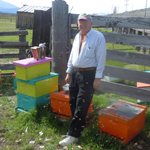At our June 4, 2018 meeting, Dr. Dewey Caron gave a talk on. “Responsible Colony Stewardship: June Management/Working Toward Treatment Free Beekeeping.”
1. Keep bee stock locally adapted.
2. Space hives as widely as possible. In nature hives are spaced about 1/2 mile apart.
3. Keep bees higher off the ground.
Tom Seeley’s book Honeybee Democracy is a wonderful source of information on how swarms choose new locations for colonies, and what they prefer.
4. Keep bees in smaller hives.
5. Encourage bee use of propolis with rough-walled hives.
“In essence, the propolis envelope acts as an external antimicrobial layer that enshrouds the colony, benefiting bee immune defenses (Simone Finstrom, et al, 2009). Yes, it seals cracks and probably provides structural support, but the main benefit is probably its antimicrobial value.”
For more information on how bees use propolis, see Dr. Marla Spivak’s article The Benefits of Propolis.
6. Use hives with thicker walls.
“In a natural bee cavity, insulation is provided by the surrounding mass of the tree. Above and below the colony is an almost infinite amount of insulation and the outside walls can be virtually any thickness, but more typically range from three to five inches. According to universally accepted standards, soft pine offers an R-value of about 1.12 per inch.4Therefore, the ¾ inch pine boxes we typically use provide an R-value of about 0.84. Conversely, a colony surrounded by five inches of wood in a natural softwood tree benefits from an R-value of about 5.6 or about six times the insulation quality of a typical bee box and that’s just the outside walls.”
Winter Management, Bee Culture OCTOBER 21, 2016

